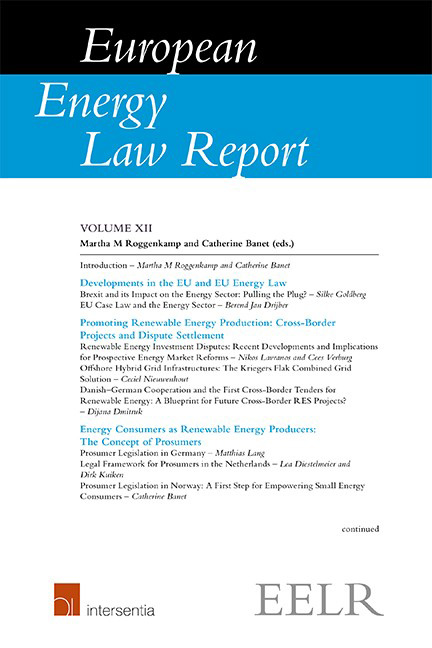Book contents
- Frontmatter
- Preface
- Contents
- List of Abbreviations
- List of Contributors
- Introduction
- PART I Developments In The EU and EU Energy Law
- PART II Promoting Renewable Energy Production: Cross-Border Projects And Dispute Settlement
- Chapter III Renewable Energy Investment Disputes: Recent Developments And Implications For Prospective Energy Market Reforms
- Chapter IV Off shore Hybrid Grid Infrastructures: The Kriegers Flak Combined Grid Solution
- Chapter V Danish-German Cooperation on the First Cross-Border Tenders for Renewable Energy: A Blueprint for Future Cross-Border RES Projects?
- PART III Energy Consumers As Renewable Energy Producers: The Concept Of Prosumers
- PART IV Balancing Renewable Electricity Production Withsupply Security: National Experiences With Capacity Mechanisms
- PART V Promoting The Use Of Sustainable Gas And Security Of Gas Supply
Chapter IV - Off shore Hybrid Grid Infrastructures: The Kriegers Flak Combined Grid Solution
from PART II - Promoting Renewable Energy Production: Cross-Border Projects And Dispute Settlement
Published online by Cambridge University Press: 31 January 2019
- Frontmatter
- Preface
- Contents
- List of Abbreviations
- List of Contributors
- Introduction
- PART I Developments In The EU and EU Energy Law
- PART II Promoting Renewable Energy Production: Cross-Border Projects And Dispute Settlement
- Chapter III Renewable Energy Investment Disputes: Recent Developments And Implications For Prospective Energy Market Reforms
- Chapter IV Off shore Hybrid Grid Infrastructures: The Kriegers Flak Combined Grid Solution
- Chapter V Danish-German Cooperation on the First Cross-Border Tenders for Renewable Energy: A Blueprint for Future Cross-Border RES Projects?
- PART III Energy Consumers As Renewable Energy Producers: The Concept Of Prosumers
- PART IV Balancing Renewable Electricity Production Withsupply Security: National Experiences With Capacity Mechanisms
- PART V Promoting The Use Of Sustainable Gas And Security Of Gas Supply
Summary
INTRODUCTION
On a shallow sandbank in the Baltic sea, a challenge to current electricity grid regulation is starting to take shape. The off shore wind farm Kriegers Flak, under Danish jurisdiction, will be connected both to the Danish onshore grid and to two German off shore wind farms, Baltic 1 and Baltic 2, which are already connected to the German coast. Thus, an electrical connection with the name Kriegers Flak Combined Grid Solution with three off shore wind farms in the middle will be constructed between Denmark and Germany. Current electricity grid regulation was not designed with this type of connection in mind. Consequently, several legal uncertainties exist regarding this new development.
First, some attention needs to be paid to terminology. There is not yet a legal or official term that covers the connection between at least two countries and at least one off shore wind farm. Such infrastructure can be used both for electricity trade and for the transport of off shore-produced electricity to the onshore electricity grid. This can thus be seen as a grid connection with hybrid functionality. In this chapter, for clarity’ s sake, this type of connection will be referred to as ‘hybrid’ grid infrastructure.
The question of terminology is of further relevance: interpretation of the terminology used in current energy law determines in which ‘ category ’ an asset falls. This has direct consequences for the way the infrastructure can be regulated, which in turn influences the profitability of the investment and eventually whether the electricity infrastructure will be constructed or not. For the development of off shore connections in the most cost-effective way, it is essential that there is clarity concerning how hybrid grid infrastructure will be defined and categorised under international, European and national law.
Therefore the terminology and categorisation for hybrid cables should be considered carefully: can hybrid grid infrastructure fit in the definitions and categories contained in the current law, or would the creation of new legal terminology be needed for the development of hybrid off shore grid infrastructure? After giving a short factual background of hybrid grid infrastructure (section 2), this chapter addresses the abovementioned question of terminology and interpretation on the basis of an analysis of international and European law (sections 3 and 4 respectively).
- Type
- Chapter
- Information
- European Energy Law Report XII , pp. 95 - 112Publisher: IntersentiaPrint publication year: 2018

